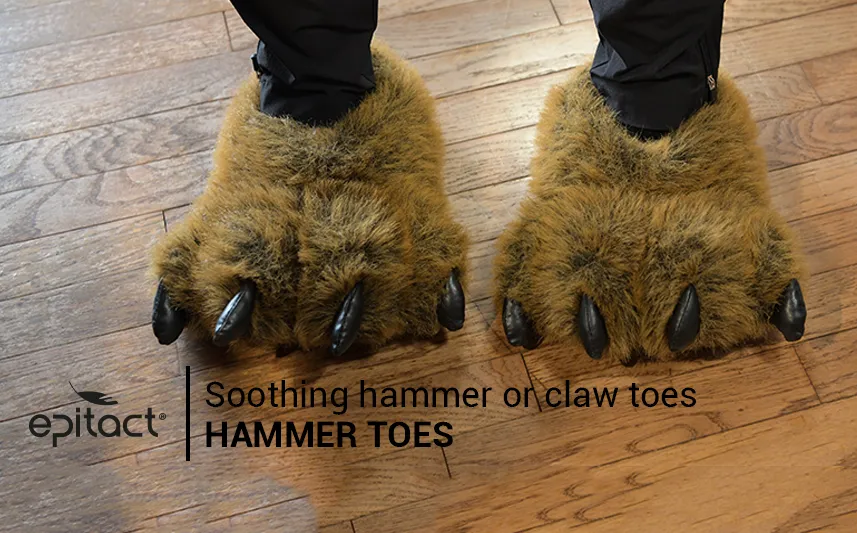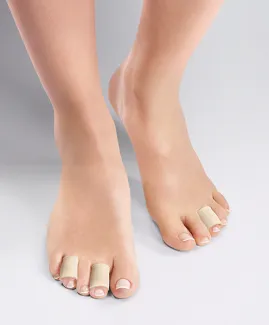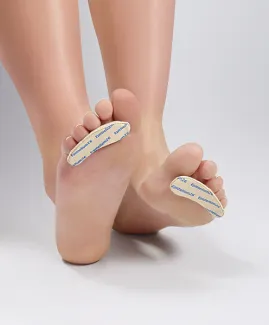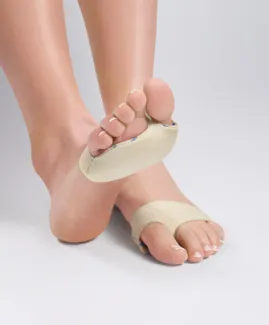
Hammer toe treatment is based on preventive and medical methods. Sometimes surgery is also needed.
Hammer toes are irreversible deformities of the toe joints. The more the deformity progresses, the more aesthetically or physically uncomfortable it becomes. Indeed, hammer toes can be very painful in the shoes due to prolonged pressure and friction against the prominent joint.
EPITACT® explains to you how to fix hammer toes without surgery and how to prevent or relieve the pain, whether it is joint pain or pain caused by a corn on the toe.
Who to see for treating hammer toes?
The first thing to do if you have bent toes is to see your general practitioner. He can assess your symptoms, determine the type of deformity, and give you the proper treatment for your hammer toes. According to the stage of the deformity, he can recommend you see another health professional:
- a podiatrist can remove a painful corn or callus on your toe and make special orthopaedic insole or toe braces that straighten the toes.
- a physical therapist does and teaches you exercises to limit the development of toe deformity while it is still flexible.
- an orthopaedic surgeon can fix your hammer toes with surgery. This treatment for hammer toes is usually required for severe and disabling deformities (intense pain, difficulties to walk, to wear shoes, etc.).
What can you do yourself for your hammer toes?
To relieve pain and limit the deformity, follow the few next steps:
- Wear shoes that are flexible and wide enough to avoid the compression or overlapping of the toes that occurs with narrow or pointed shoes. This is one of the first recommendation of treatment for hammer toes. Please note that narrow and tight shoes may also cause other deformities like a bunion.
- Avoid high heels that increase the pressure on the ball of the foot and help the development of hammer toes. Indeed, wearing high heels transfers the body weight from the heel to the forefoot. Such a pressure causes hyperextension of the joint at the base of the toe (the metatarsophalangeal joint). Then, it forces the first interphalangeal joint (the farthest to the toenail) to go up. So, choose shoes with a small heel (<4 cm) helps to fix hammer toes.
- Try to lose weight, if it is necessary, is also part of the treatment of hammer toes. Being overweight increase pressure under the forefoot and overload the joints.
- Use silicone protections* on your toes to ease the pain in the shoes.
- Wear special pads for hammer toes* to preserve joint flexibility. Before using such devices, check that you can still flex your bent toe.
How to fix hammer toes with medical treatments?
Even if bent toes can’t be totally fixed other than by surgery, hammer toe treatment aims to slow down and limit the deformity while it is mild or moderate. If you can flex the affected toe(s), it means the joint is still flexible and it is possible to straighten your toe(s). In this case, your general practitioner can recommend you see a podiatrist who can:
- Make orthopaedic insoles if he considers that your hammer toes are caused by cavus foot, fallen arches, hallux valgus, etc. Insoles for such foot problems support the arch of the foot to restore proper foot pressure on the ground, which encourages toes to bend when they are disproportionate. - Make toe braces help to fix a hammer toe as they keep the toe aligned and protect it from painful contacts with the shoe.
- Use a tape or a strap, which are bandages placed around the toe to improve its alignment. These devices are particularly indicated if the toe joint is still flexible.
- Recommend to wear silicone cushions that help to straighten the toes and limit the pressure with the shoe. They also avoid joint stiffness of the toes.
Physical treatment for hammer toes
Hammer toe treatment includes physical therapy, especially at an early or moderate stage. These deformities generally develop because of unequal strength between the flexor and extensor tendons of the toes. This muscle imbalance can cause the tendon to retract, pulling on the toe and causing it to curl.
The physical therapist can restore mobility and function of your toes. To do that, he or she realises rehabilitation exercises based on muscle strengthening and tendon stretching. He or she can also teach you some exercises to do at home.
How to relieve corns on hammer and claw toes?
As we just said above, treatment of hammer toes starts with wearing well-fitting and comfortable shoes.
Pain in the shoe comes from the pressure and friction between the shoe and the prominent joint. Such repeated and prolonged stresses can lead to the formation or painful corns.
Specialist in foot care for 25 years, EPITACT® has developed silicone protections that prevent and relieve corns on toes. They can be used at any stage, before or after the podiatrist’s care:
- The Digitubes® sleeves* protect the corns located on top or between the toes (dorsal or interdigital corns).
- The Digitops* protect corns on the tip of the toe (apical corns).
- The hammer toe cushions* perfectly fit the area underneath your toes to help them unfold and straighten. As a result, the pressure from the shoe on the distal or middle joint of your toe is reduced, the pain is relieved and formation of corns is limited.
How to treat a corn on your hammer toe?
If you have painful or recurrent corns on your hammer toes, the treatment includes regular consultation of your podiatrist. Same advice if you have diabetes or a problem of blood circulation in your legs. After your podiatrist has removed the corn, you can wear toe protections* mentioned just above to avoid it reappear.
At home, you can also limit the formation of corns by gently sanding dead skin with a pumice stone (no more than once a week). Then, moisturise your feet every day.
These tips also apply to calluses under the forefoot, which can be a consequence of hammer toes. Calluses are thick areas of skin usually on the ball of the foot, which can cause discomfort when walking. To relieve calluses, try the EPITACT®’s metatarsal pads*!
Hammer toes: treatment of an inflamed corn
Inflammation of a corn characterises by redness and a sensation of heat over the corn. It usually affects corns located between two toes. Sometimes, the corn becomes infected. In both cases, consult your GP who can prescribe antibiotics.
Surgery is the last way to strengthen your toes
Surgery is the last-line treatment approach for hammer toes. It is only performed if medical treatments have been insufficient. Just as there are different types of deformity, there are many different surgical techniques. In another article, learn how to fix hammer toes with surgery.
To sum up, hammer toe treatment includes appropriate shoes, exercises, protections, skin care and orthopaedic insoles. Perhaps the best advice we can give you is to have your hammer toes treated now if they are not already. By preventing them from developing, you can avoid complications such as difficulties with footwear, walking and balance, potential surgery, joint pain and the formation of corns and calluses.
*These solutions are class I medical devices that bear the CE marking under this regulation. Carefully read the instructions before use. Manufacturer: Millet Innovation. 03/2024
Sources:
Cazeau C,Stiglitz Y, Piat C. Pathologie des petits orteils. Revue du Rhumatisme Monographies. 1 avr 2014;81(2):101-8
Hannan MT, Menz HB, Jordan JM, Cupples LA, Cheng CH, Hsu YH. High Heritability of Hallux Valgus and Lesser Toe Deformities in Adult Men and Women: Heritability of Hallux Valgus and Toe Deformities in Adults. Arthritis Care & Research. sept 2013;65(9):1515‑21.
Diebold PF. Pathologie non traumatique des orteils. EMC - Appareil locomoteur. janv 2009;4(3):1‑6.
Rodríguez-Sanz D, Tovaruela-Carrión N, López-López D, Palomo-López P, Romero-Morales C, Navarro-Flores E, et al. Foot disorders in the elderly: A mini-review. Disease-a-Month. 1 mars 2018;64(3):64‑91.
Frey-Ollivier S, Catena F, Hélix-Giordanino M, Piclet-Legré B. Treatment of Flexible Lesser Toe Deformities. Foot and Ankle Clinics. mars 2018;23(1):69‑90.
 Pharmacie
Pharmacie


